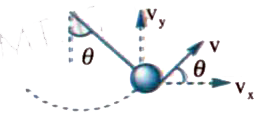Consider a pendulum consisting of a nuscless string with a mass on the end. The mass is held with the string horizontal, and then released. The mass swings down, and on its way back up, the string is cut at point P when it makes an angle of θ with the vertical. Find θ if that mass covers maximum horizontal range.

The speed at angle θ is given by conservation of energy.
12mv2=mgh⇒12mv2=mgRcosθv=√2gRcosθ
When string is cut particle moves as a projectile with velocity component.
vx=vcosθvy=vsinθ
The time of flight is t=2(vyg)
Range is, x=vxt=vx(2vyg)
=2vxvyg=2(vcosθ)(vsinθ)g
=2v2sinθcosθg=2(2gRcosθ)sinθcosθg=4Rcos2θsinθ
Take the derivative of this function and equate it to zero
Thus we get 0=4R[(−2cosθsinθ)sinθ+cos2θcosθ] (or)
2sin2θcosθ=cos3θ(or)tanθ=1/√2

Similar Questions
A rod of mass m and length l is held vertically on a smooth horizontal floor. Now it is released from this position, find the speed of its centre of mass when it makes an angle θ with the vertical.
View SolutionIn a simple pendulum, the breaking strength of the string is double the weight of the bob. The bob is released from rest when the string is horizontal. The string breaks when it makes an angle θ with the vertical.
View Solution
Knowledge Check
- Question 1 - Select One
In a simple pendulum, the breaking strength of the string is double the weight of the bob. The bob is released from rest when the string is horizontal. The string breaks when it makes an angle θ with the vertical.
Aθ=cos−1(1/3)Bθ=60∘Cθ=cos−1(2/3)Dθ=0 - Question 2 - Select One
A simple pendulum is released from rest with the string in horizontal position. The vertical component of the velocity of the bob becomes maximum, when the string makes an angle θ with the vertical. The angle θ is equal to
Aπ4Bcos−1(1√3)Csin−1(1√3)Dπ3 - Question 3 - Select One
A simple pendulum of length L swings in a vertical plane. The tension of the string when it makes an angle θ with the vertical and the bob of mass m moves with a speed v is (g is the gravitational acceleration)
Amv2/LBmgcosθ+mv2/LCmgcosθ−mv2/LDmgcosθ
A simple pendulum is released from rest with the string in horizontal position. The vertical component of the velocity of the bob becomes maximum, when the string makes an angle θ with the vertical. The angle θ is equal to
View SolutionA simple pendulum has a bob of mass m and swings with an angular amplitude ϕ. The tension in thread is T. At a certain time the string makes an angle θ with the vertical (θ≤ϕ)
View SolutionA pendulum consists of a small mass m at the end of a string of length L. The pendulum is pulled aside making an angle θ with the vertical and released. Taking the suspension point as the axis, at the instant of release
View SolutionA simple pendulum has a bob of mass m and swings with an angular amplitude ϕ. The tension in thread is T. At a certain time the string makes an angle θ with the vertical (θ≤ϕ)
View SolutionA pendulum consists of a small mass m at the end of a string of length L. The pendulum is pulled aside making an angle θ with the vertical and released. Taking the suspension point as the axis, at the instant of release
View Solution
